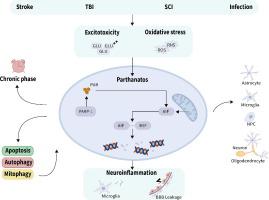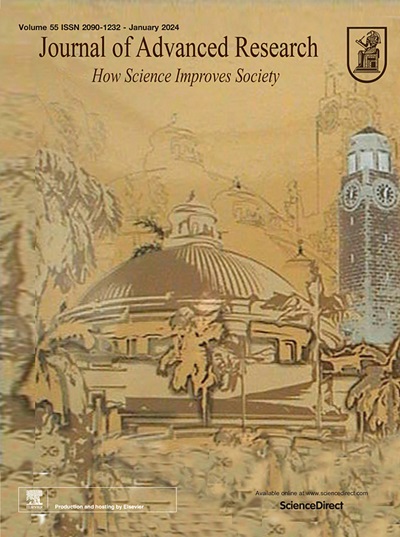探索副交感神经在中枢神经系统损伤中的作用:分子见解和治疗方法。
IF 11.4
1区 综合性期刊
Q1 MULTIDISCIPLINARY SCIENCES
引用次数: 0
摘要
背景:中枢神经系统(CNS)损伤会导致严重的器官损伤,这既是由于损伤造成的损害,也是由于随后的细胞死亡。然而,目前还没有有效的治疗方法来应对细胞功能不可逆转的丧失。Parthanatos 是一种依赖于聚(ADP-核糖)聚合酶 1(PARP-1)的程序性细胞死亡形式,是造成神经细胞死亡的部分原因。因此,parthanatos促进中枢神经系统损伤的机制引起了科学界的极大兴趣:我们的综述旨在总结副交感神经在中枢神经系统损伤中的潜在作用及其分子和病理生理学机制。了解副交感神经和相关分子在中枢神经系统损伤中的作用对于制定有效的治疗策略和确定未来深入研究的重要方向至关重要:Parthanatos(源自希腊神话中死亡的化身Thanatos)是一种程序性细胞死亡,由PARP-1的过度激活引发。这一过程会引发一连串反应,包括聚(ADP-核糖)(PAR)的积累、凋亡诱导因子(AIF)从线粒体释放后的核转运,以及随后迁移抑制因子(MIF)与 AIF 形成复合物导致的大量 DNA 断裂。继发性分子机制,如兴奋毒性和氧化应激诱导的 PARP-1 过度激活,显著加剧了中枢神经系统初次机械损伤后的神经元损伤。此外,parthanatos 不仅与神经元损伤有关,还与其他各种类型的细胞死亡相互作用。本综述侧重于有关副交感神经细胞死亡途径的最新研究,特别是考虑其在中枢神经系统损伤中的调控机制和功能。我们强调了parthanatos与中枢神经系统损伤所涉及的不同细胞类型之间的关联,并讨论了针对parthanatos通路的潜在治疗药物。本文章由计算机程序翻译,如有差异,请以英文原文为准。


Exploring the role of parthanatos in CNS injury: Molecular insights and therapeutic approaches
Background
Central nervous system (CNS) injury causes severe organ damage due to both damage resulting from the injury and subsequent cell death. However, there are currently no effective treatments for countering the irreversible loss of cell function. Parthanatos is a poly (ADP-ribose) polymerase 1 (PARP-1)-dependent form of programmed cell death that is partly responsible for neural cell death. Consequently, the mechanism by which parthanatos promotes CNS injury has attracted significant scientific interest.
Aim of review
Our review aims to summarize the potential role of parthanatos in CNS injury and its molecular and pathophysiological mechanisms. Understanding the role of parthanatos and related molecules in CNS injury is crucial for developing effective treatment strategies and identifying important directions for future in-depth research.
Key scientific concepts of review
Parthanatos (from Thanatos, the personification of death according to Greek mythology) is a type of programmed cell death that is initiated by the overactivation of PARP-1. This process triggers a cascade of reactions, including the accumulation of poly(ADP-ribose) (PAR), the nuclear translocation of apoptosis-inducing factor (AIF) after its release from mitochondria, and subsequent massive DNA fragmentation caused by migration inhibitory factor (MIF) forming a complex with AIF. Secondary molecular mechanisms, such as excitotoxicity and oxidative stress-induced overactivation of PARP-1, significantly exacerbate neuronal damage following initial mechanical injury to the CNS. Furthermore, parthanatos is not only associated with neuronal damage but also interacts with various other types of cell death. This review focuses on the latest research concerning the parthanatos cell death pathway, particularly considering its regulatory mechanisms and functions in CNS damage. We highlight the associations between parthanatos and different cell types involved in CNS damage and discuss potential therapeutic agents targeting the parthanatos pathway.
求助全文
通过发布文献求助,成功后即可免费获取论文全文。
去求助
来源期刊

Journal of Advanced Research
Multidisciplinary-Multidisciplinary
CiteScore
21.60
自引率
0.90%
发文量
280
审稿时长
12 weeks
期刊介绍:
Journal of Advanced Research (J. Adv. Res.) is an applied/natural sciences, peer-reviewed journal that focuses on interdisciplinary research. The journal aims to contribute to applied research and knowledge worldwide through the publication of original and high-quality research articles in the fields of Medicine, Pharmaceutical Sciences, Dentistry, Physical Therapy, Veterinary Medicine, and Basic and Biological Sciences.
The following abstracting and indexing services cover the Journal of Advanced Research: PubMed/Medline, Essential Science Indicators, Web of Science, Scopus, PubMed Central, PubMed, Science Citation Index Expanded, Directory of Open Access Journals (DOAJ), and INSPEC.
 求助内容:
求助内容: 应助结果提醒方式:
应助结果提醒方式:


